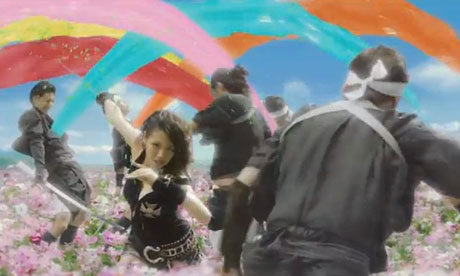Jealousy (Philippe Garrel, France, 2013)
Another day, another 'Maestro'-selection I don't get. Who is Philippe Garrel? The name honestly doesn't ring any bells. But at least he is old. And apparantly a mainstay at Venice. Well, I found this article at Senses of Cinema, which talks about him, but it is 13 years old. Underground, auto-biographical, pared-down cinema. Well, it sort of fits with this one as well. It also claims that Garrel is the best filmmaker working today, which is a surprise to me.
Jealousy is a pretty simple film on the lovelife of the creative class. That makes it the third film sorta on this subject I've seen this year, after Our Sunhi and Free Range. Honestly, I'm getting a bit bored by it. It's very unassuming and simply build: Louis leaves the mother of his child, and moves in with another woman. They grow apart. She leaves him. 77 min. Austere but beautiful black and white. I liked how the world kept opening up, as the main characters flirted with more and more people. Louis is played by Louis Garrel, the son of the director, and his sister is played by his sister, Esther. It's a fine little film.
Thing is, though. La Jalousie is a pretty famous book in France. By Alain Robbes-Grillet. A classic of the Nouveau Roman. The film definitely recognizes this famous book, as it begins with a scene of the young daughter spying on her parents breaking up through a keyhole, just as the unseen narrator of La Jalousie is spying through a jalousie window. And, well, I can't really get over the fact that this film borrows the title from one of the most famous examples of French experimental fiction, and then uses it for a pretty ordinary and stale relationship drama. It just seems wrong, and perhaps even a bit sad. And it's not as if anyone should wonder how to do Robbe-Grillet filmically, the guy made films and wrote the script for Last Year in Marienbad. And it didn't look like this.
I have nothing against the film. The pictures are exquisite, some of the scenes are unique and brilliant, like a tracking shot of the new couple in the beginning of their relationship, which follows them in focus, while the world behind them is reduced to a blur. What I think is totally possible, is that if I saw a few more Garrel-films, if I knew more of his world, then this latest dispatch would mean more to me. Kinda like with Hong Sang-soo. But I don't, and as such, I'm a bit in the dark. If you like American indies, but would wish they were more Gallic, then this is a film for you. But other than that, I think there are better places to start in Garrel's filmography.
Jealousy is shown again Wed 4/16 at 17:00
Why Don't You Play in Hell? (Sion Sono, 2013, Japan)
Okay, this was insane. 1) Check out the trailer above. It's insane. 2) The screening of this film was completely ridiculous, there were black borders on all four side of the picture, and at one point the film started hiccuping, and we missed quite a lot of it. More on this later.
Sion Sono was one of my discoveries at last years festival. I saw his Land of Hope with no expectations, mainly because I'm interested in the Fukushima accident, and found it extremely wellmade and beautiful. I knew it was an outlier in his production, that he is normally a more extreme kind of director, so I wasn't that surprised by this films journey into complete insanity. Still: It's an extremely weird film. It revolves around two warring Yakuza-families; a group of guerilla filmmakers calling themselves The Fuck Bombers; the young daughter of the one Yakuza-boss, famous from an insanely catchy toothpaste commercial. Somehow, it all devolves into the filmmakers filming the final showdown between the two families, and carnage ensues. If it sounds needlessly complicated, well, it is, and the setup for this film takes forever. But the last half hour or so is amazingly fun.
Sion Sono is quite simply a good director, and the film is full of indelible images, many of them glimpsed in the trailer. The young girl dancing in a sea of blood, the yakuza-men squirting a rainbow of blood, loads more. And the jokes are timed and paced, so simple cuts elicited big laughs in the cinema. There is also one big stylistic gamble in the film: The first part, taking place ten years before, is filmed in 35 mm, while the main part is digital. This creates a massive amount of nostalgia, both in the film, as the flashbacks in the second part has the look of an actually older time, and just for the death of celluloid occuring over the decade, which the young filmmakers are acutely aware of. It's a great little thing. It did create problems though, as the hiccuping began when the style switched, and I'm almost certain it had something to do with the shift, though I can't explain how. Anyway, it meant that the part after the timejump became quite imcomprehensible, and that was where the main plotlines were set up, so I'm pretty sure I missed quite a bit of the plot.
Having only watched two of his films, I'd still put Sion Sono up there with the best of the Japanese directors of the new century. These two films pretty much match any Miike, Kore-eda, (late-period) Kitano, Kiyoshi Kurosawa, etc, I've seen, which admittedly isn't anything. Still, I'm going to check out the rest of his ouvre, and if you get the chance to watch this bonkers b-film action/comedy/splatter, then I'd very much recommend it.
Why Don't You Play In Hell is shown again Mon 4/7 at 19:00.

Ingen kommentarer:
Send en kommentar